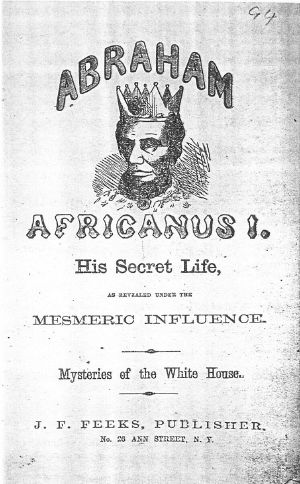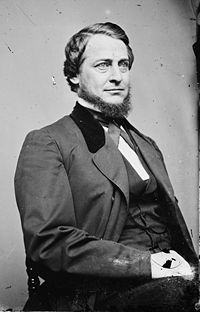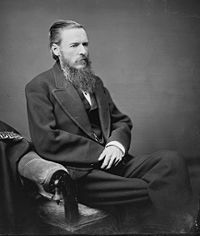Copperheads
The Copperheads were a faction of Democrats in the North (see also Union (American Civil War)) who opposed the American Civil War, wanting an immediate peace settlement with the Confederates. The name Copperheads was given to them by their opponents the Republicans, because of the copper liberty-head coins they wore as badges and the idea that they were poised to strike at the nation like a deadly snake. They were also called "Peace Democrats" and "Butternuts." The most famous Copperhead was Ohio's Clement L. Vallandigham, who was a vehement opponent of President Abraham Lincoln's policies.
Debate continues about whether the Civil War and all its bloodshed (3.09 percent of the population) could have been avoided. The Copperheads did not avert the Civil War, nor can they be said to have totally repudiated violence. Some of them also held racist views. Nonetheless, the principle that negotiation and diplomacy take priority over armed resolution of differences did inform their polity. This principle has since been enshrined into the Charter of the United Nations and is thus part of international law. The Copperheads advocated this principle at a time when some thought negotiation too risky an enterprise, too prone to compromise and accommodation, and wanted outright victory instead, which only war could deliver. The Copperheads did not survive, nor did they attract enough support to achieve their aim. That aim, though, was commendable in the face of what proved to be one of history's bloodiest civil wars.
Agenda
During the American Civil War (1861-1865), the Copperheads nominally favored the Union but strongly opposed the war, for which they blamed abolitionists, and they demanded immediate peace and resisted draft laws. They wanted Lincoln and the Republicans ousted from power, seeing the president as a tyrant who was destroying American republican values with his despotic and arbitrary actions. Most were not disloyal, instead they fostered an intense suspicion of the way the war was being conducted and its influence on the Northern populace.[1]
Some Copperheads tried to persuade Union soldiers to desert. They talked of helping Confederate prisoners of war seize their camps and escape. They sometimes met with Confederate agents and took money. The Confederacy encouraged their activities whenever possible.[2] Most Democratic party leaders, however, repelled Confederate advances.
Some historians, such as Richard Curry, have downplayed the treasonable activities of the Copperheads, arguing that they were simply people who fiercely resisted modernization and wanted to return to the old ways. Copperheads distrusted monopolies and a strong central government, urging instead more power for the states. Most shared an antiblack sentiment and were drawn from specific ethnic groups descendant of Europeans.[3]
Newspapers
The Copperheads had numerous important newspapers, but the editors never formed an alliance. In Chicago, Wilbur F. Storey made the Chicago Times into Lincoln's most vituperative enemy. The New York Journal of Commerce, originally abolitionist, was sold to owners who became Copperheads, giving them an important voice in the largest city in the North. A typical editor was Edward G. Roddy, owner of the Uniontown, Pennsylvania Genius of Liberty. He was an intensely partisan Democrat who saw black people as an inferior race and Abraham Lincoln as a despot and dunce. Although he supported the war effort in 1861, he blamed abolitionists for prolonging the war and denounced the government as increasingly despotic. By 1864 he was calling for peace at any price.
John Mullaly's Metropolitan Record was the official Catholic paper in New York City. Reflecting Irish opinion, it supported the war until 1863 before becoming a Copperhead organ; the editor was then arrested for draft resistance. Even in an era of extremely partisan journalism, Copperhead newspapers were remarkable for their angry rhetoric. "A large majority [of Copperheads]," declared an Ohio editor, "can see no reason why they should be shot for the benefit of niggers and Abolitionists." If "the despot Lincoln" tried to ram abolition and conscription down the throats of white men, "he would meet with the fate he deserves: hung, shot, or burned."[4] Through the 1864 election, Lacrosse, Wisconsin Democratic newspaper editor Marcus Mills "Brick" Pomeroy called Lincoln "fungus from the corrupt womb of bigotry and fanaticism" and a "worse tyrant and more inhuman butcher than has existed since the days of Nero.... The man who votes for Lincoln now is a traitor and murderer.... And if he is elected to misgovern for another four years, we trust some bold hand will pierce his heart with dagger point for the public good." Other popular Copperhead editors included Charles Lanphier of Springfield's Illinois State Register, Samuel Medary of Columbus, Ohio's Crisis, and Dennis Mahoney of Dubuque, Iowa's Herald.[5]
Copperhead Resistance
The Copperheads sometimes talked of violent resistance, and in some cases started to organize. They never actually made an organized attack, though. As war opponents, Copperheads were suspected of disloyalty, and Lincoln often had their leaders arrested and held for months in military prisons without trial. Probably the largest Copperhead group was the Knights of the Golden Circle; formed in Ohio in the 1850s, it became politicized in 1861. It reorganized as the Order of American Knights in 1863, and again, early in 1864, as the Order of the Sons of Liberty, with Clement L. Vallandigham as its commander. One leader, Harrison H. Dodd, advocated violent overthrow of the governments of Indiana, Illinois, Kentucky, and Missouri in 1864. Democratic party leaders, and a Federal investigation, thwarted his conspiracy. In spite of this Copperhead setback, tensions remained high. The Charleston Riot took place in Illinois in March of 1864. Indiana Republicans then used the sensational revelation of an antiwar Copperhead conspiracy by elements of the Sons of Liberty to discredit Democrats in the 1864 House elections. The military trial of Lambdin P. Milligan and other Sons of Liberty revealed plans to set free the Confederate prisoners held in the state. The culprits were sentenced to hang but the Supreme Court intervened in Ex parte Milligan, saying they should have received civilian trials.
Most Copperheads actively participated in politics. On May 1, 1863, former Ohio Congressman Vallandigham declared that the war was being fought not to save the Union but to free the blacks and enslave Southern whites. The Army then arrested him for declaring sympathy for the enemy. He was court-martialed and sentenced to imprisonment, but Lincoln commuted the sentence to banishment behind Confederate lines. The Democrats nevertheless nominated him for governor of Ohio in 1863; he campaigned from Canada but was defeated after an intense battle. He operated behind the scenes at the 1864 Democratic convention in Chicago; this convention adopted a largely Copperhead platform, due in large part to the fact that the committee responsible for drafting it was composed mainly of peace advocates, but chose a pro-war presidential candidate, George B. McClellan. The contradiction severely weakened the chances to defeat Lincoln's reelection, especially after McClellan denounced the peace platform that the party had drafted for him. Though the Copperheads had reached their highest point following dismal Union defeats in campaigns such as Fredericksburg and Chancellorsville, they would lose appeal in the aftermath of Gettysburg and Vicksburg. The Copperheads would reach their lowest point following the Union Army's success in the Atlanta Campaign. Eventually the faction died out in favor of Republican virtues following the party's success in the 1864 elections and Union military triumph following the Confederate surrender at Appomatax in April 1865.[6]
Michael Crawford Kerr
Michael C. Kerr (March 15, 1827‚ÄďAugust 19, 1876) was an American legislator elected to Congress in 1864 as a "war" Democrat, having vigorously opposed the Copperhead element in his district. He was born in Titusville, Pennsylvania, was educated at the Erie Academy and graduated from the law school of Louisville University in 1851. He removed to New Albany, Indiana, in 1852, and was a member of the Indiana State Legislature in 1856-1857. He served in the United States House of Representatives as a Democrat from Indiana from 1865 to 1873. In Congress he was looked upon as one of the leaders of the Democratic Party. He strongly opposed the Republican policy of reconstruction in the Southern states. He was not reelected in 1872. His views on financial questions did not meet with favor in his constituency, where he openly antagonized the inflationists and the "greenback" element and favored the resumption of specie payments. In 1874, however, after a sharp contest, he was reelected, and on his reentry into Congress was elected to the speaker's chair. He presided as Speaker at only the first session of the Forty-fourth Congress and died of consumption shortly after its adjournment.
In 1866, when Michael Kerr ran for the office of United States Congressman from Indiana against General Walter Q. Gresham, Kerr made the statement that he was not involved with the Southern sympathizers, known as the Sons of Liberty, whose trial for treason had been held in Indianapolis earlier. The trial's Judge Advocate General Henry L. Burnett was involved in the decisions as to which of those questioned had committed offenses great enough to cause them to be brought to trial, and which testimonies would be used only for information. Michael Kerr escaped prosecution because Burnett had decided not to bring him to trial. Upon hearing that Kerr claimed to have had no part in the conspiracy, Burnett made a speech in the New Albany public square to a large crowd. The speech was printed as a newspaper broadsheet.
In intent, in spirit, in purpose, he [Kerr] was a traitor. I say this, fellow citizens, dispassionately, and am responsible for what I say here or elsewhere. I KNOW MICHAEL C. KERR WAS A MEMBER OF THE ORDER, FOR HE CONFESSED IT TO ME HIMSELF TIME AND AGAIN when I had him in Indianapolis, trembling for his miserable life. I wish he were here now, that I might tell him to his teeth that he admitted to me‚ÄĒand never thought of denying it‚ÄĒmaking it the basis of all our conversation, that he was a Son of Liberty.
Although exposed as a member of the conspiracy by Burnett, Kerr was elected to Congress. General Burnett had been one of the Special Judge Advocates at the trial of Abraham Lincoln's assassination conspirators.[7]
Profile of the Average Member
The sentiments of Copperheads attracted Southerners who had settled north of the Ohio River, conservatives, the poor, and merchants who had lost profitable Southern trade.[8] Copperheads did well in local and state elections in 1862, especially in New York, and won majorities in the legislatures of Illinois and Indiana.[9] Copperheads were most numerous in border areas, including southern parts of Ohio, Illinois, and Indiana (in Missouri, comparable groups were avowed Confederates). The Copperhead coalition included many Irish American Catholics in eastern cities, mill towns, and mining camps (especially in the Pennsylvania coal fields). They were also numerous in German Catholic areas of the Midwest, especially Wisconsin.
Historian Kenneth Stampp has captured the Copperhead spirit in his depiction of Congressman Daniel W. Voorhees of Indiana:
There was an earthy quality in Voorhees, "the tall sycamore of the Wabash." On the stump his hot temper, passionate partisanship, and stirring eloquence made an irresistible appeal to the western Democracy. His bitter cries against protective tariffs and national banks, his intense race prejudice, his suspicion of the eastern Yankee, his devotion to personal liberty, his defense of the Constitution and State's rights faithfully reflected the views of his constituents. Like other Jacksonian agrarians, he resented the political and economic revolution then in progress. Voorhees idealized a way of life which he thought was being destroyed by the current rulers of his country. His bold protests against these dangerous trends made him the idol of the Democracy of the Wabash Valley.[10]
Notes
- ‚ÜĎ Tap, Bruce, "Copperheads,‚ÄĚ Encyclopedia of the American Civil War: A Political, Social, and Military History, (New York: W. W. Norton & Company, 2000), 498-499.
- ‚ÜĎ Tidwell, William A., April '65: Confederate Covert Action in the American Civil War. (Kent: Kent State University Press, 1995), 155-20.
- ‚ÜĎ Tap, Bruce, "Copperheads,‚ÄĚ Encyclopedia of the American Civil War: A Political, Social, and Military History, (New York: W. W. Norton & Company, 2000), 498-499.
- ‚ÜĎ McPherson, James M., Battle Cry of Freedom: The Civil War Era, (New York: Oxford University Press, 1988), 560.
- ‚ÜĎ Tap, Bruce, "Copperheads,‚ÄĚ Encyclopedia of the American Civil War: A Political, Social, and Military History, (New York: W. W. Norton & Company, 2000), 498-499.
- ‚ÜĎ Tap, Bruce, "Copperheads,‚ÄĚ Encyclopedia of the American Civil War: A Political, Social, and Military History, (New York: W. W. Norton & Company, 2000), 498-499.
- ‚ÜĎ Van Deusen, Mary S., Gen. H.L. Burnett‚Äôs Speech at New Albany, Friday, Oct. 5, 1866. Retrieved September 28, 2007.
- ‚ÜĎ Norton, Mary Beth, et al., eds., A People & A Nation, A History of the United States, 6th ed. (Boston: Houghton Mifflin Co., 2001), 393-395.
- ‚ÜĎ Norton, Mary Beth, et al., eds., A People & A Nation, A History of the United States, 6th ed. (Boston: Houghton Mifflin Co., 2001), 393-395.
- ‚ÜĎ Stampp, Kenneth M., Indiana Politics during the Civil War, (Bloomington: Indiana University Press, 1978), 211.
ReferencesISBN links support NWE through referral fees
- Curry, Richard O. "Copperheadism and Continuity: the Anatomy of a Stereotype." Journal of Negro History 57(1) (1972): 29-36.
- Curry, Richard O. "The Union as it Was: a Critique of Recent Interpretations of the 'Copperheads'." Civil War History 13(1) (1967): 25-39
- George Jr., Joseph. "'Abraham Africanus I': President Lincoln Through the Eyes of a Copperhead Editor." Civil War History 14(3) (1968): 226-239.
- Gray, Wood. The Hidden Civil War: The Story of the Copperheads. New York: Viking Press, 1942.
- Klement, Frank L. The Copperheads in the Middle West. Madeira Park: Peter Smith Publishing Inc., 1960.
- Klement, Frank L. The Limits of Dissent: Clement L. Vallandigham and the Civil War. New York: Fordham University Press, 1998. ISBN 0823218910
- Klement, Frank L. Lincoln's Critics: The Copperheads of the North. Shippensburg: White Mane Publishing Company, 1999.
- Klement, Frank L. Dark Lanterns: Secret Political Societies, Conspiracies, and Treason Trials in the Civil War. Baton Rouge: Louisiana State University Press, 1985.
- McPherson, James M. Battle Cry of Freedom: The Civil War Era (Oxford History of the United States). New York: Oxford University Press, 1988. ISBN 0195038630
- Milton, George F. Abraham Lincoln and the Fifth Column. Seattle: Vanguard Press, 1942.
- Nevins, Allan. ‚ÄúThe Improvised War.‚ÄĚ The War for the Union. Vol. 1. New York: Charles Scribner's Sons Ltd., 1959.
- Nevins, Allan. ‚ÄúWar Becomes Revolution.‚ÄĚ The War for the Union. Vol. 2. New York: Charles Scribner's Sons Ltd., 1960.
- Nevins, Allan. ‚ÄúThe Organized War.‚ÄĚ The War for the Union. Vol. 3. New York: Charles Scribner's Sons Ltd., 1971.
- Nevins, Allan. ‚ÄúThe Organized War to Victory.‚ÄĚ The War for the Union. Vol. 4. New York: Charles Scribner's Sons Ltd., 1971.
- Norman, Mary Beth, et al., eds. A People & A Nation, A History of the United States. 6th ed. Boston: Houghton Mifflin Co., 2001. ISBN 0618005536
- Silbey, Joel H. A Respectable Minority: The Democratic Party in the Civil War Era, 1860-1868. New York: W.W. Norton & Company, 1977.
- Stampp, Kenneth M. Indiana Politics during the Civil War. Bloomington: Indiana University Press, 1978.
- Tap, Bruce. "Copperheads." In Encyclopedia of the American Civil War: A Political, Social, and Military History, 498-499. New York: W. W. Norton & Company, 2000. ISBN 039304758X
- Tidwell, William A. April '65: Confederate Covert Action in the American Civil War. Kent: Kent State University Press, 1995.
- Van Deusen, Mary S. Gen. H.L. Burnett’s Speech at New Albany, Friday, Oct. 5, 1866. Retrieved May 4, 2020.
- Walsh, Justin E. "To Print the News and Raise Hell: Wilbur F. Storey's Chicago 'Times'." Journalism Quarterly 40(4) (1943): 497-510
- Weber, Jennifer L. Copperheads: The Rise and Fall of Lincoln's Opponents in the North. New York: Oxford University Press, 2006. ISBN 0195306686
- Wubben, Hubert H. Civil War Iowa and the Copperhead Movement. Ames: Iowa State Press, 1980.
External Links
All links retrieved January 7, 2024.
- Making of America. The Old Guard.
Credits
New World Encyclopedia writers and editors rewrote and completed the Wikipedia article in accordance with New World Encyclopedia standards. This article abides by terms of the Creative Commons CC-by-sa 3.0 License (CC-by-sa), which may be used and disseminated with proper attribution. Credit is due under the terms of this license that can reference both the New World Encyclopedia contributors and the selfless volunteer contributors of the Wikimedia Foundation. To cite this article click here for a list of acceptable citing formats.The history of earlier contributions by wikipedians is accessible to researchers here:
The history of this article since it was imported to New World Encyclopedia:
Note: Some restrictions may apply to use of individual images which are separately licensed.


